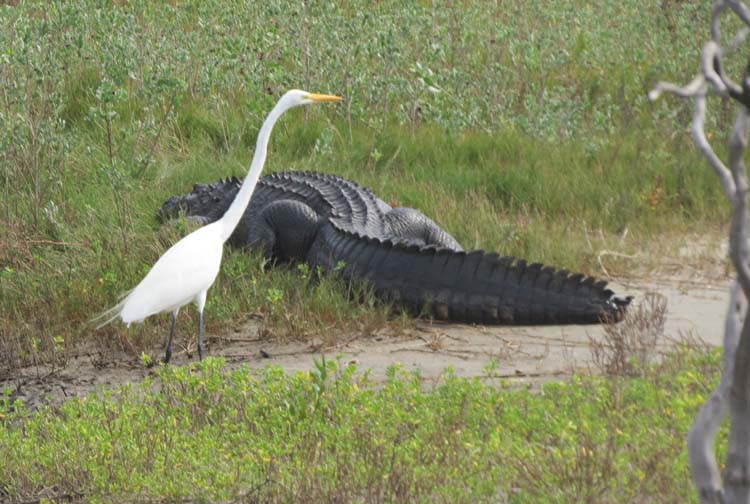
21 Nov We mess with Texas!
Posted at 01:31h
in
Essays,
sightings
by EdNewbold
Posted Nov. 20, 2015 from Seattle, WA
I’ve heard “Don’t mess with Texas” my whole life. If I took it seriously, I would probably go to Florida, Hawaii or California to find subtropical birds in the US, rather than “messing” with Texas. But Delia and I and the indomitable Brian Pendleton recently decided to call Texas’s bluff and go there anyway.
It turned out to be a good idea! It’s fun to go down there and mess around looking for birds and nature. People in Texas are as nice as can be and we had a wonderful time. Everyone should mess with Texas!
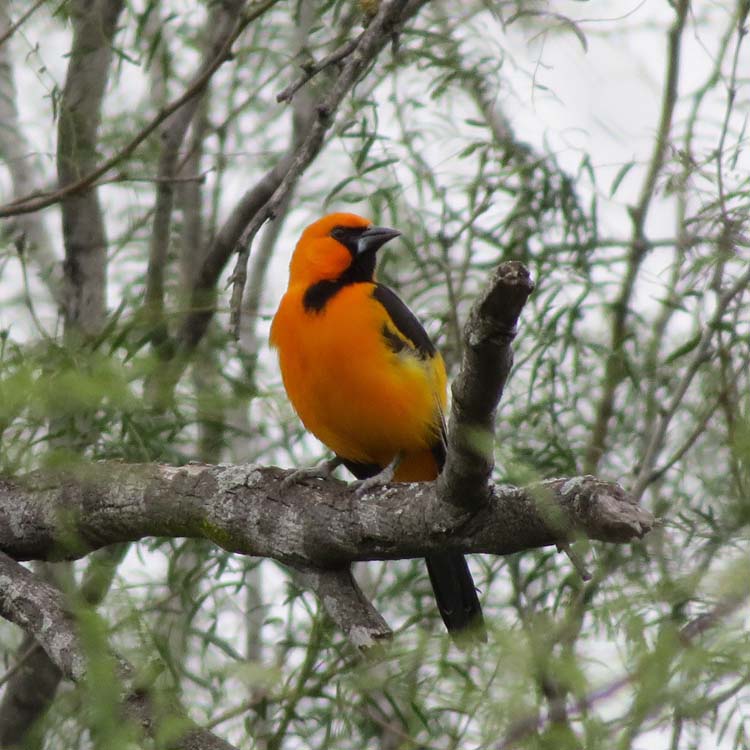
We flew in to McAllen on Nov 12th and our first stop next morning was at Salineno, that second n is an enya, a nature area further upstream on the Rio Grande. This Altamira Oriole, our largest Oriole, stopped to pose for us there. We also had a pair of Audubon’s Orioles at the blind, where seeing these birds can be as easy as shooting fish in a barrel.
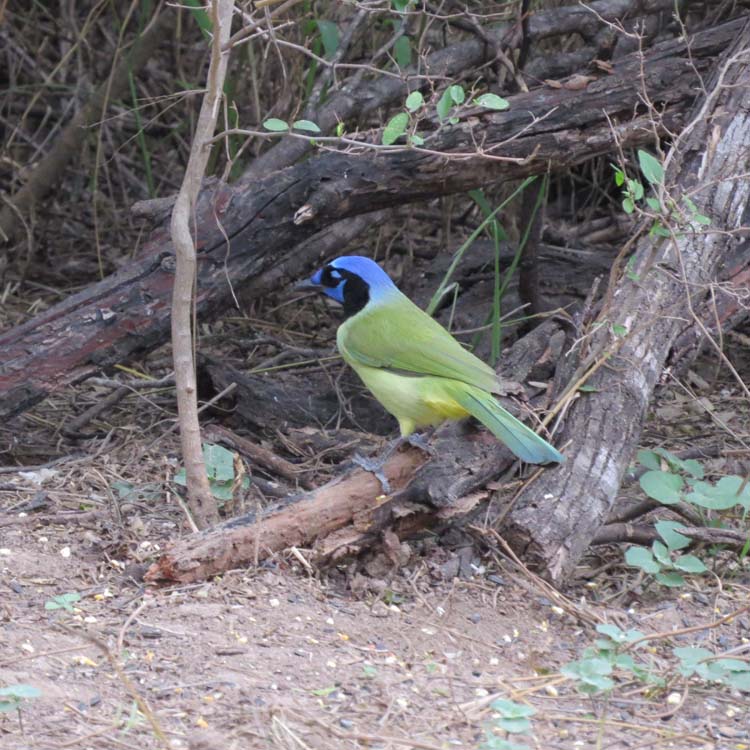
There’s even more Green Jays in South Texas than there are Border Patrol agents, and it’s a gorgeous bird. But it being so common and easy to photograph, I guess that created a perverse psychology and it turns out I took hardly any photographs of them after this first shot. It doesn’t show their flashy yellow in the tail which makes them so easy to identify when they are flying away.
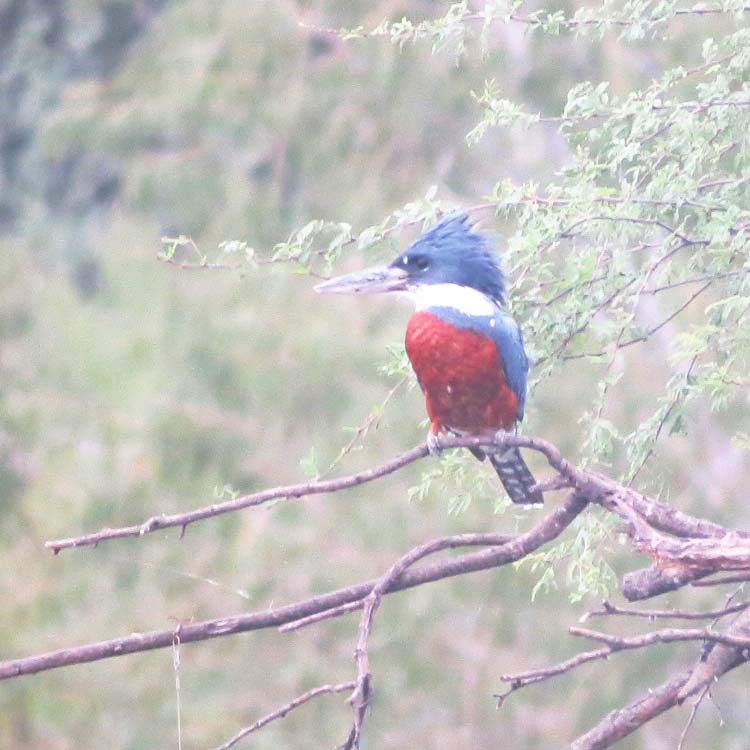
Our next stop was Benson State Park on the Rio Grande where in the evening I found this Ringed Kingfisher. This has always been the most astonishing bird for me. A rather huge Kingfisher that is so brightly colored it damages the retina, quite unlike the Belted Kingfisher which is also in South Texas. Unbelievable bird, I hate to choose a trip bird but this one sort of knocked me over. This is a male, the female has a blue chest-band fringed in white over the same red (it’s more accessorized), would love to get a good look at that.

On the second day we visited Estero Llano on the Rio Grande, downstream from McAllen, and we found a colony of Groove-billed Anis plus this White-tailed Kite, a bird that holds a special place in my heart.

These Black-bellied Whistling Ducks were also at Estero.

Northern Cardinals can be found many places besides South Texas, but I don’t get tired of them and these birds seemed a tad brighter than I’ve seen elsewhere, and there were lots of them. It also has Pyrrhuloxias.
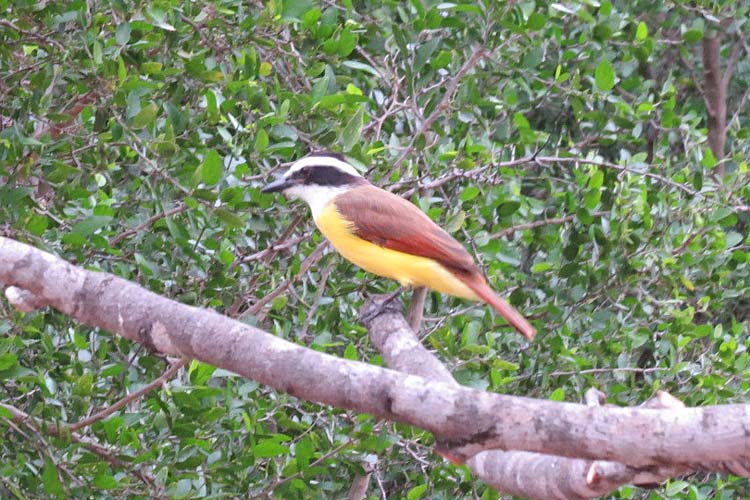
Here’s another colorful bird that is really abundant in South Texas and I didn’t take enough shots to get a really good shot, the Great Kiskadee. They also make a lot of noise. This shot shows what they look like and shows their color well, but a straight side-view isn’t normally the most dynamic shot.
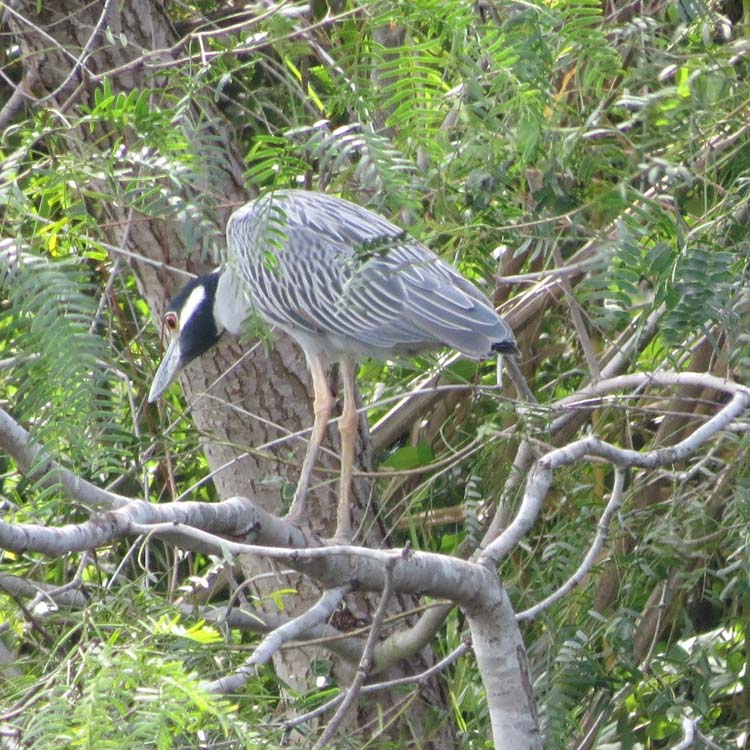
A Yellow-crowned Night Heron was at Estero along with it’s cousin the Black-crowned Night Heron.
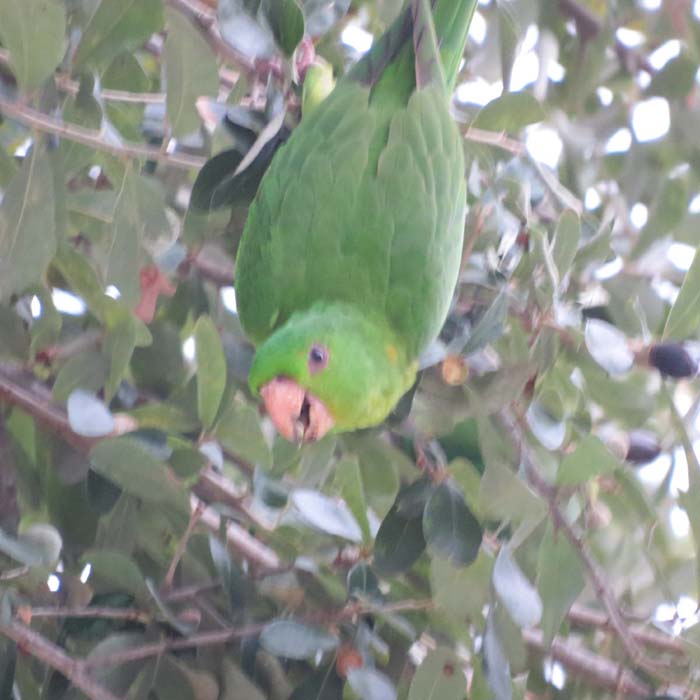
In the evening our guide Mary Beth steered us to the right street in McAllen where a couple hundred Green Parakeets come to roost at night. The Green Parakeet is a native bird in South Texas and Northern Mexico. They have a sense of humor like all Psittacines and noticed us watching them and this bird hung upside down 10 feet from our can and took a good look at us. The genus is Aratinga, so it’s related to the Parrot that lived in Eastern US but was driven extinct, the Carolina Parakeet.
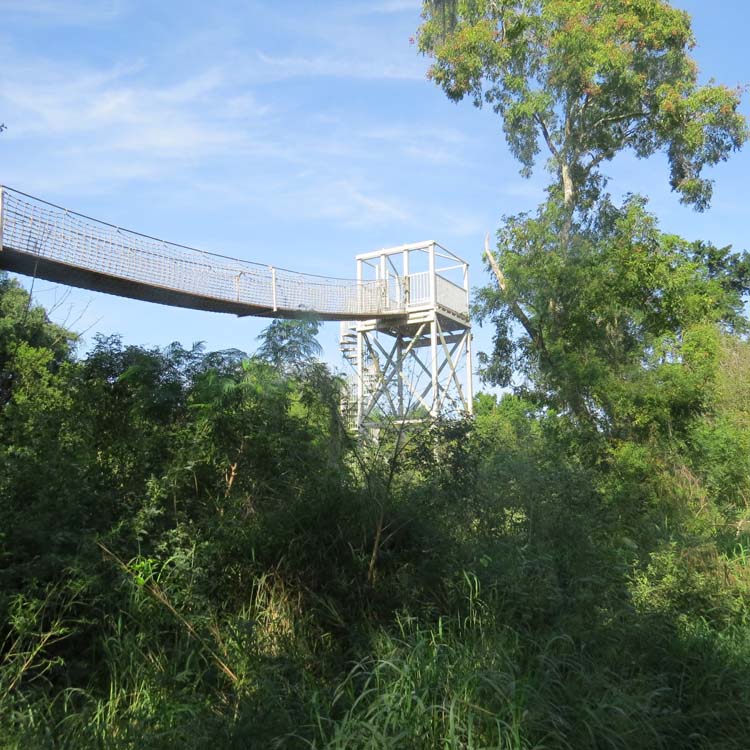
On Sunday we headed down the road from Alamo, where we were staying, to Santa Ana National Wildlife Refuge. Here’s the canopy walk at Santa Ana. There’s also a tower.
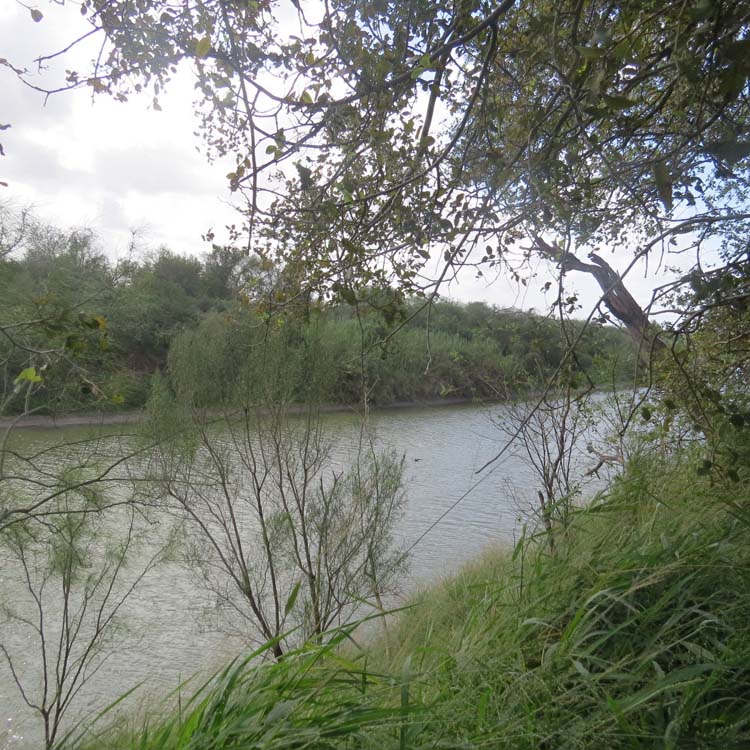
Here’s the Rio Grande at Santa Ana.

This is me at Santa Ana wearing Texas-War-Paint, AKA sunscreen. I had plenty to put on we hadn’t been using the sunscreen much in Seattle lately.
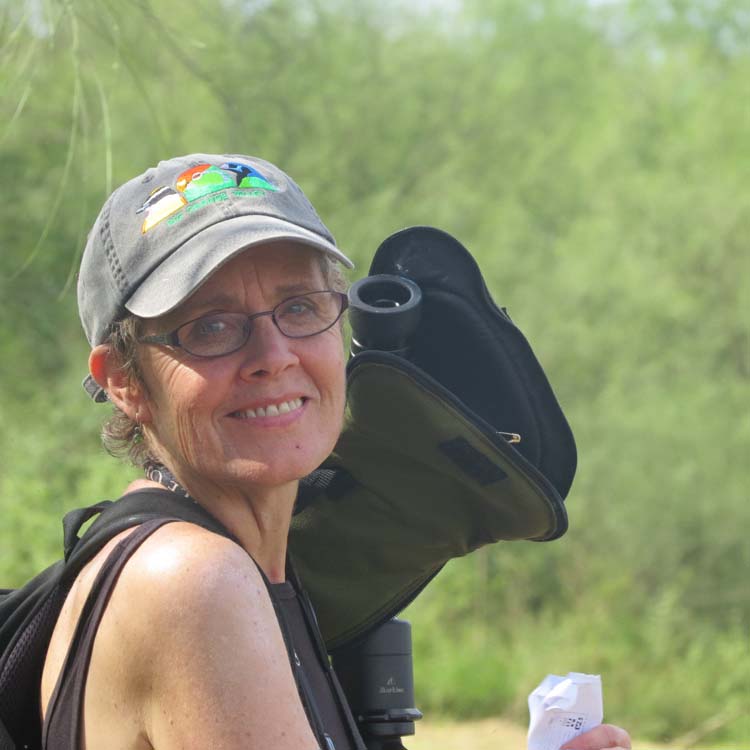
Delia on her last day, she had to get back to Seattle for a Monday work-week start. Notice she’s carrying a scope. It’s not ours, we’re scope-parasites: We don’t own one but are happy to look through other people’s. Of course, by carrying the scope what Delia is doing is not parasitism, but commensalism. I practice a purer form of scope-parasitism.
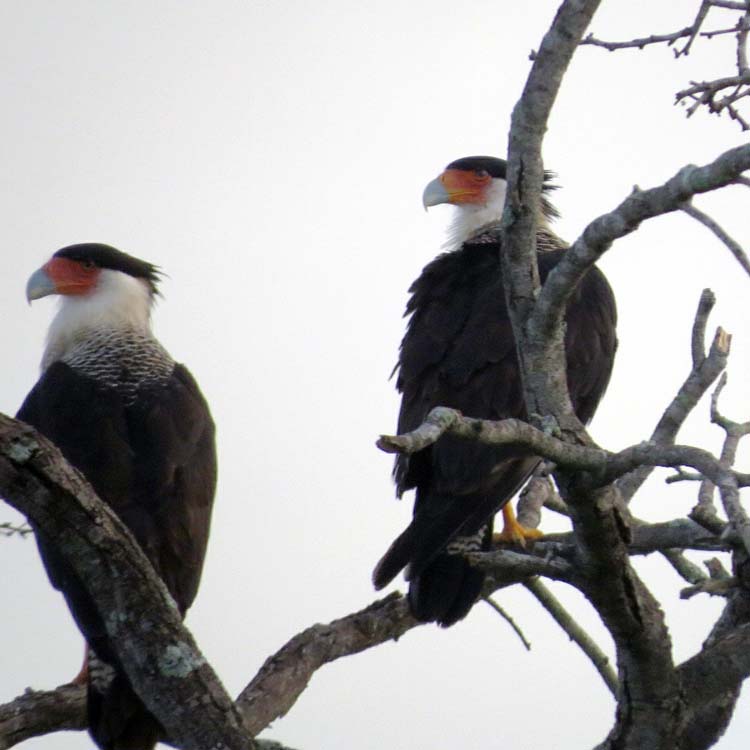
We head up 150 miles north into the Tamalipas Thorn-scrub forest, to a place called Choke Canyon, to look for Fulvous Whistling Duck and Northern Jacana. On the way we spot these two Crested Caracaras (actually, we spotted many Crested Caracaras.)
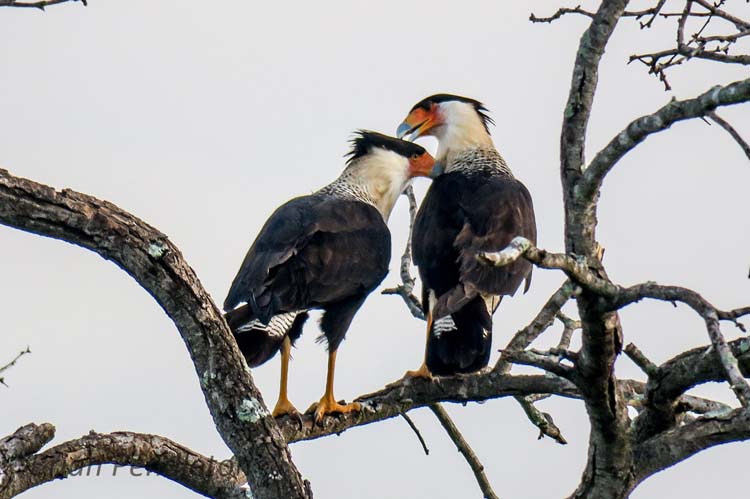
Here’s a photo of the two birds a minute later. Brian took this shot (as you can see also, it’s a lot sharper.) This shot gives you a whole lot more information: these birds are in love!
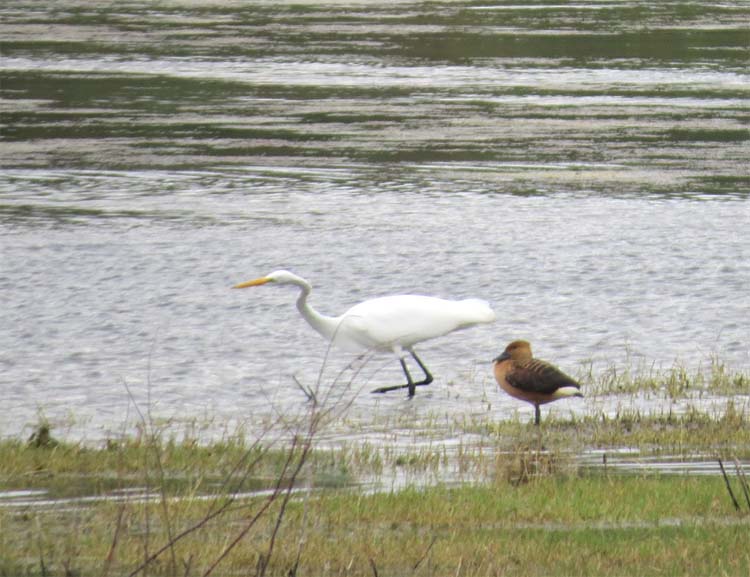
We find the Fulvous Whistling Ducks right away, here’s one posing with a Great Egret, but after scoping for an hour or so we were beginning to lose hope of locating the Northern Jacana in all the reeds at the fringe of the big 75 acre lake. We know that’s how big it is because its name is “75 Acre Lake.” I was napping in the car in an empty parking lot when suddenly a woman named Nicole whom we had met two days earlier at Anzalduis Park bombs into the parking lot. She sets up her scope and finds the bird after just 10 minutes, saving us from what would have been a big dip! She also points out a big distant Water Moccasin wrapped around a log.
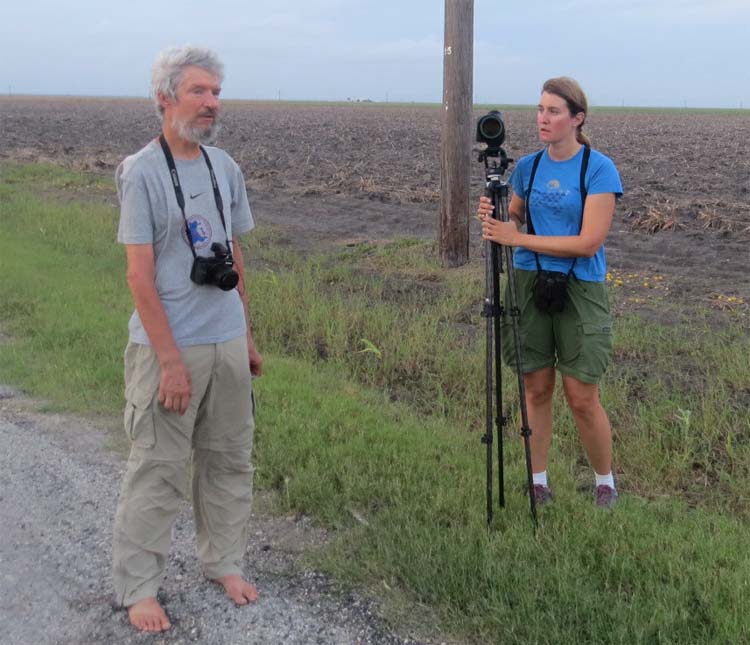
Nicole suggests we all try for some Mountain Plovers seen recently near Bishop. That would be a lifebird for her, for me and a 38-year bird for Brian, so that’s a no-brainer. But we arrive at the site as daylight is fading and, although we do manage to catch a flock of 200 Long-billed Curlews and a flying squadron of Sandhill Cranes on the way, the well-camouflaged plains-dwelling Plovers get the best of us. We treat at a really great Mexican restaurant that’s close by and then head back to McAllen. It’s an eastward direction for Nicole, she’s doing a Big-Year and heading East, she has to be back in Georgia by Thanksgiving.

The next day we head out early for the coast with our guide from the first two days, Mary Beth, who is based out of the Alamo Inn. First on the agenda is to find the Aplomado Falcons that have been reintroduced to South Texas. The serious listers aren’t supposed to count these birds because they are not yet naturalized, but for us lower-class birders, it’s open season. We find a pair but the shots I get are really terrible. They were about a half-mile away and a fierce wind was blowing, I was happy to get them in the field of view. But what made the sighting magical was the way the pair played with each other in the wind, doing high-speed, arcing dives on the other, apparently for the fun of it. Moving on we crossed over to South Padre, which is a big city with high-rise buildings everywhere. There were a few remnant pieces of wetland fringe on Padre with small Mangrove forests but they all had for-sale signs indicating they’ll soon be parking lots.
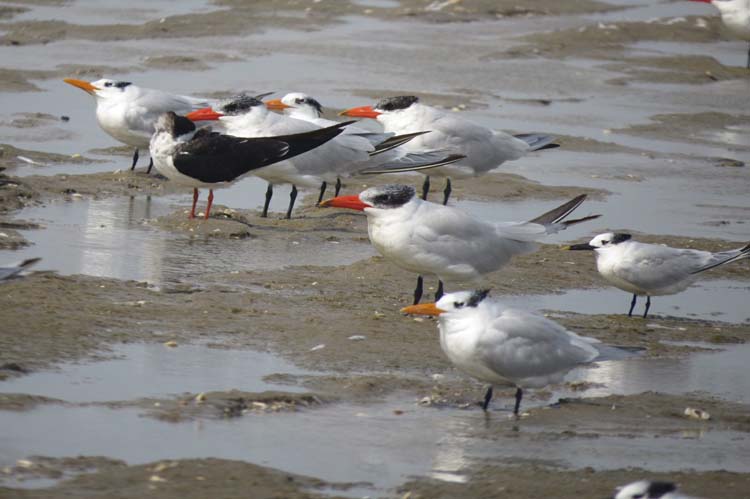
Encountered many species of Terns at the World Birding Center and a nearby beach. Orange bill are Royal Terns, red bill are Caspian Terns, black bill with a yellow tip is Sandwich Tern and bright red bill but it’s hidden and all you see is a long black wing is a Black Skimmer. We also had Common Terns, Forster’s Terns and Gull-billed Terns. I like the Terns.
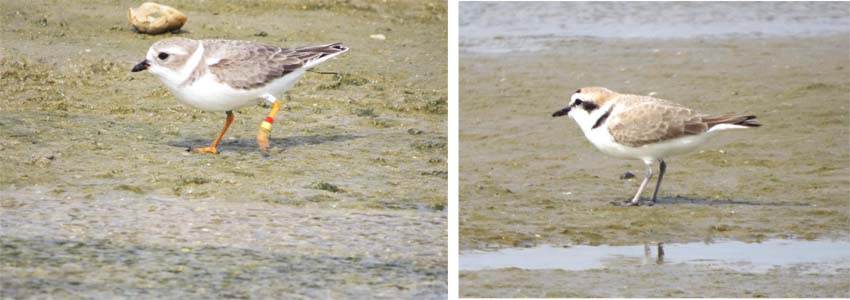
And Piping Plover, left and Snowy Plover, right. I sure hope the biologists know what they are doing putting all those bands on the Piping’s legs. Both species were present along with Dunlins, Ruddy Turnstone, Semipalmated Plover and Willets.

Of course Mary Beth knew immediately this bird a Reddish Egret (white phase): It was dancing and it’s the only Egret that habitually hunts that way. A bit later a Snowy Egret started dancing in the Mangroves and that confused me for a moment, but I soon realized the Snowy wasn’t the professional caliber dancer that the Reddish Egret was, more like a good amateur.
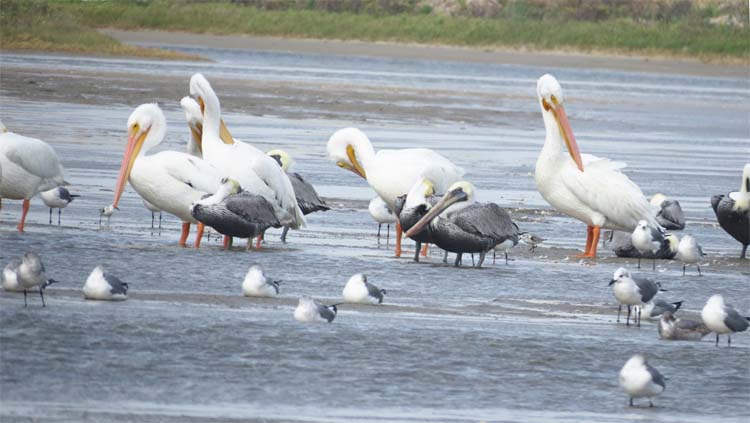
I didn’t realize just how much bigger a White Pelican is than a Brown Pelican. This shot puts that on the table.
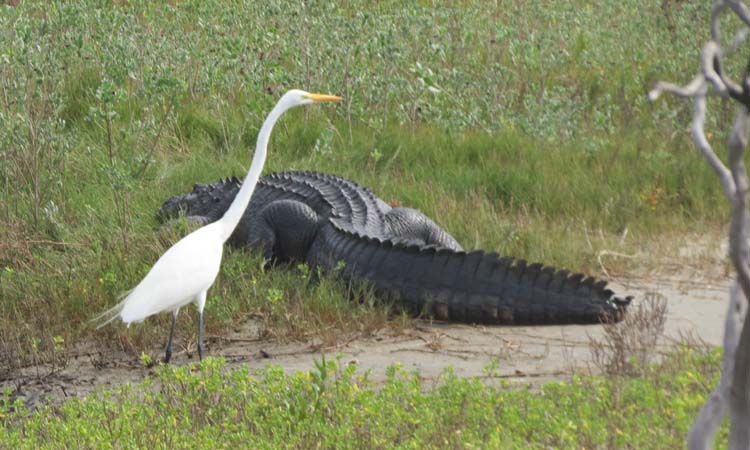
Also at the Center, this Great Egret came cautiously over to check out an Alligator. It seemed like the Egret was wondering if the Alligator had any table scraps left over from it’s last meal. These birds will do almost anything to make the cover-shot of this blog!
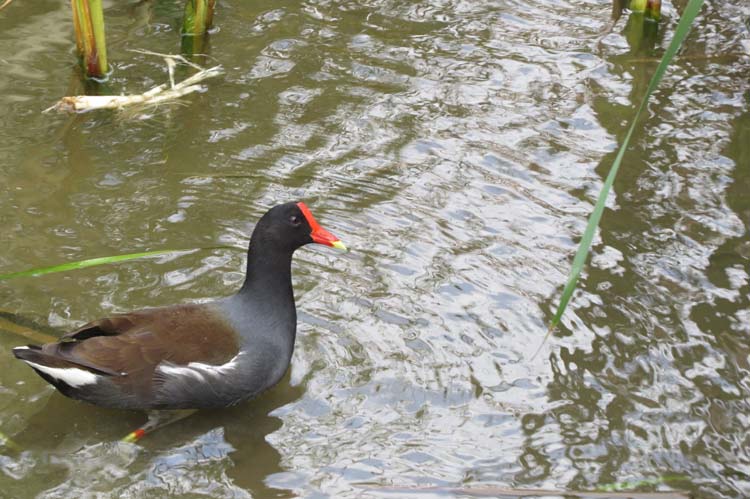
Common Gallinules were present at the Padre Islands World Birding Center. I didn’t remember how fancy-looking they were.
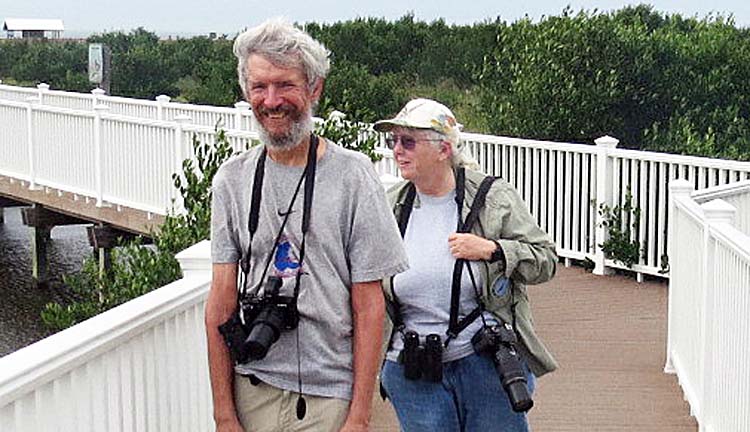
Mary Beth is the only person I ever met who got into birding through sound rather than the sight of birds. She was arguing with a friend about which song was a Baltimore Oriole’s (this was in Michigan) Mary Beth thought one song was the Oriole, her friend was sure a different song was the Oriole. To resolve the problem Mary Beth began investigating birds songs with the help of a record her parents got for her. Turns out, neither song was the Oriole’s, but that started a quest to learn vocalizations of birds and she was truly amazing in her expertise. That’s her and Brian.
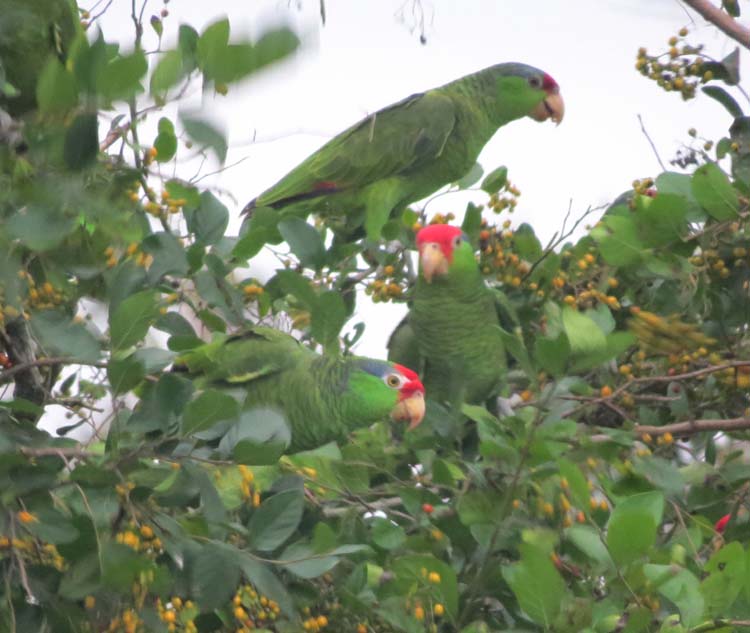
On the way back we stop at Brownsville to visit the roost of the Red-crowned Parrots.
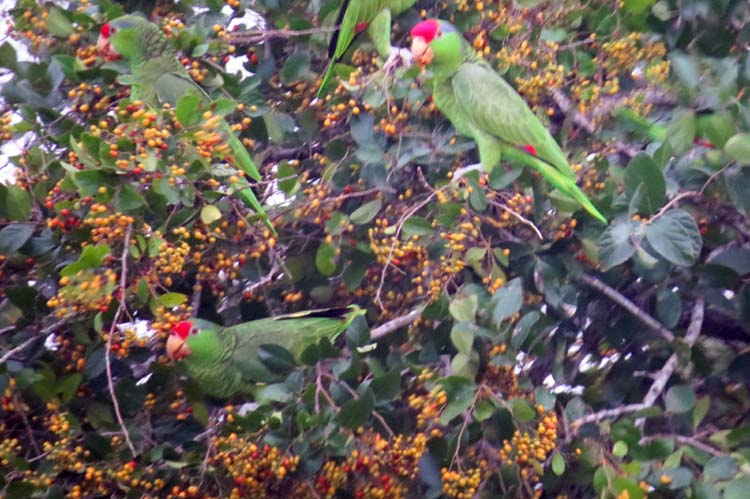
Here’s another shot of those, what a gorgeous Parrot. This is also a native, not a flock of feral escapees or anything like that, the native big Parrot of Northeast Mexico and SE Texas and closely related to it’s western cousin the Groove-billed Parrot which has been lost from SE Arizona.
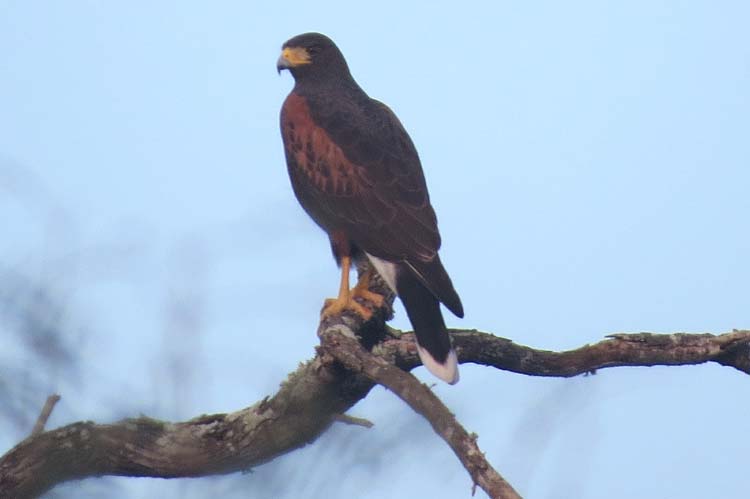
I guess it was Wednesday we went back to Benson State Park. This Harris Hawk posed there. We had White-tailed, Gray Hawk, Red-shouldered Hawk, Swainson’s Hawk, Broad-winged and Zone-tailed Hawk plus 2 accipiter hawks and 3 falcons during the course of the trip. In spite of much looking, wishing and attempts at turning other birds into it, we never found a Hook-billed Kite.
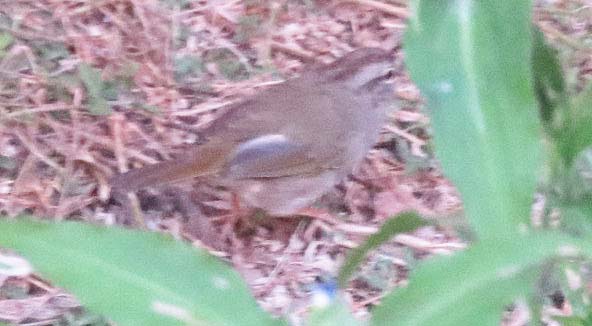
On the way out of Benson I was delighted to finally get a look at a bird we learned the call of the first day at Salineno, but I had not gotten a good look at. I had heard them many times, but finally a pair of Olive Sparrows obligingly came out onto the sidewalk at the Interpretive Center as night was falling and I got to see what they looked like.
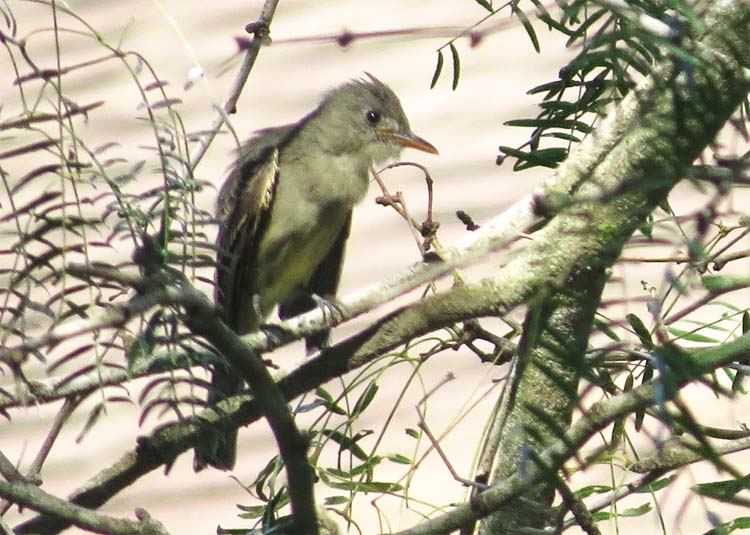
Next day we headed back to Anzalduis County Park, hoping mostly for a Hook-billed Kite. There was a flock of Eastern Bluebirds there plus a number of Warblers, some White-eyed Vireos, a Tyrannulet and a Greater Pewee which is a rarity in the Rio Grande more easily found in Arizona, but not that easily. This is the Greater Pewee.
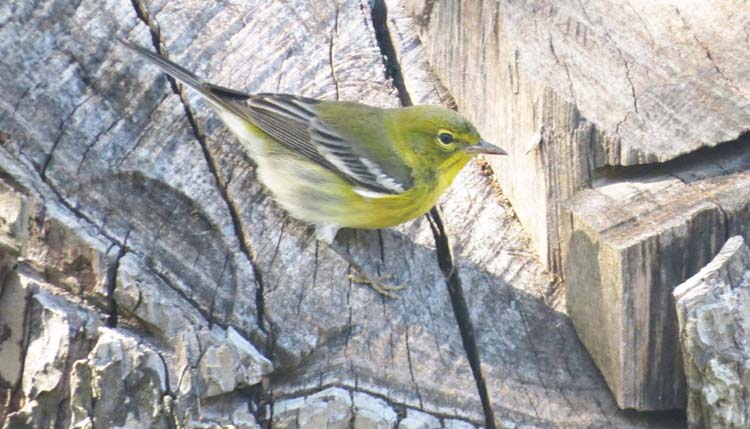
One of the Pine Warblers at Anzelduis.
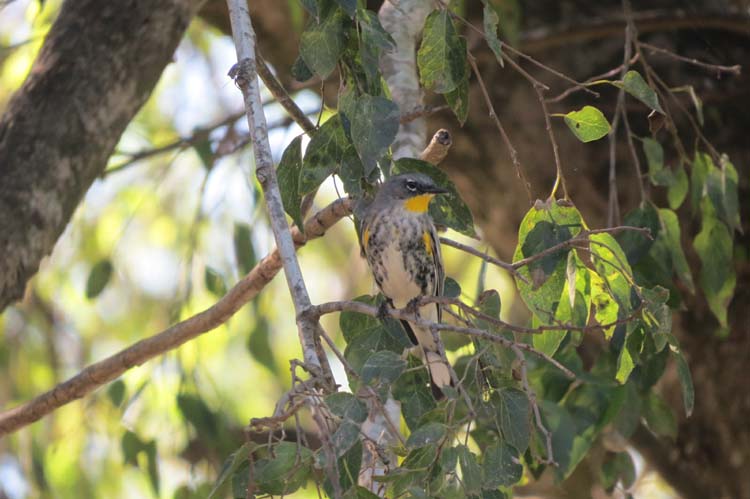
A Yellow-rumped Warbler at Anzelduis.
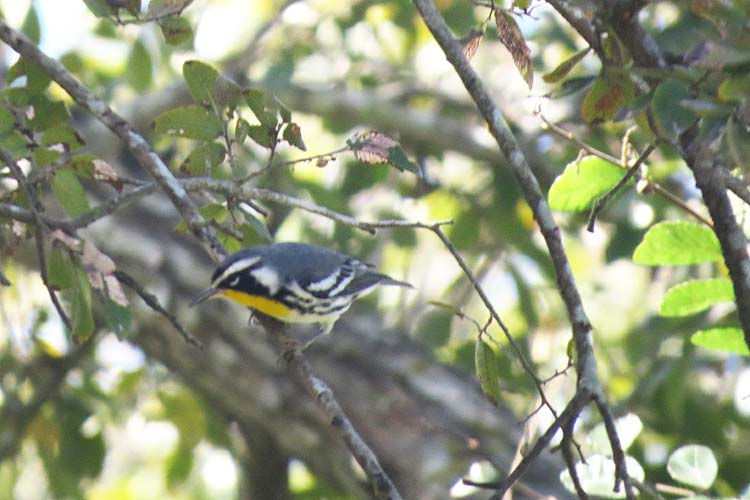
This was Brian’s and my nemesis warbler on the Great Midwest Warbler Safari of 2014 , see these blog pages, a Yellow-throated Warbler, a southern enough bird that we missed it on the Safari along with Worm-eating and of course, in case you happen to know about Eastern warblers, Swainson’s Warbler we also missed. Bachman’s is extinct now, so I don’t think that counts as a miss.
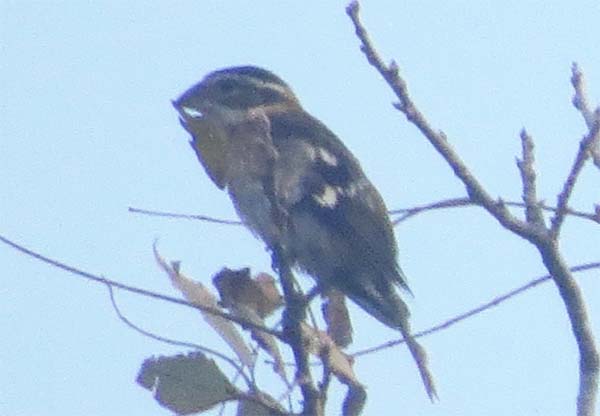
On our last day the 19th we headed back to Estero. This was a enjoyable morning. We birded with Cheryl (sp) and Dvori who weren’t together but we all had the same idea of working the western side of the park for a Tropical Parula that had been seen there. We found it, no good photos, but also had another Blue-headed Vireo, a Rose-breasted Grosbeak, a Nashville Warbler and a Northern Beardless Tyrannulet. The Grosbeak, shown above, is a male but is in winter plumage so not the dandy he’d be in the summer.
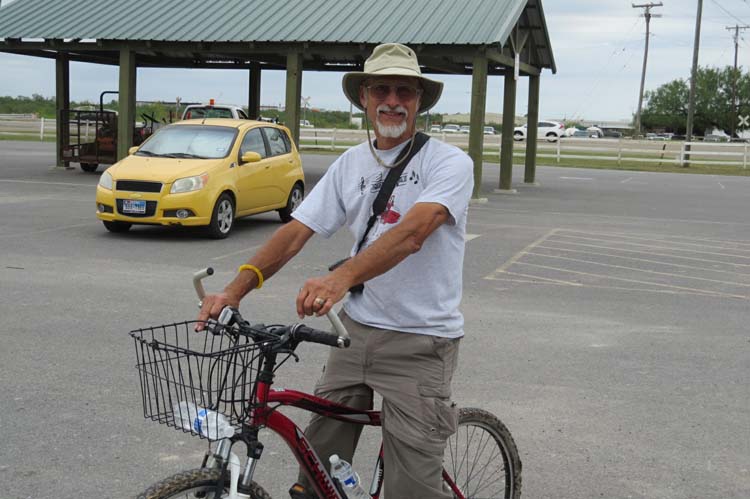
After picking up the Tropical Parula we made a quick run to Mission Nature Center. We ran into a guy in the lot named Sig who had physical activity kind of written all over him and he was there to mountain-bike the trail. It was great to see the place getting attention and use and helping people stay healthy, this is one of the many places where Moutain-biking is part of the solution.
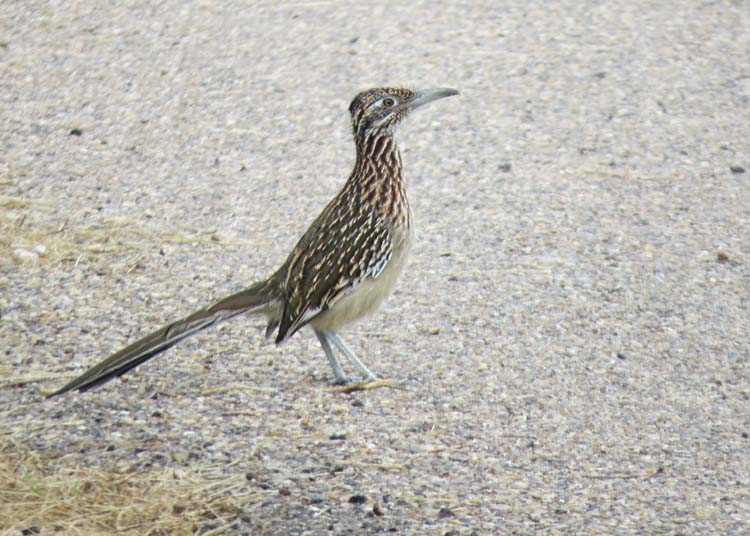
I’ve never seen such a density of Road-runners as at Mission. We’d gone there on the advice of Huck at Estero llano, look that guy up if you ever go there, that Hooked-billed Kites forage for tree snails in the old-growth Mesquite there. We didn’t get lucky on those but we did pick up our two last birds there, a Cactus Wren and a Cassin’s Sparrow. The Cactus Wren Brian “mined” from a photo he took of birds we looked at but were too far away. When he put the shot up on his computer, he could see one had been a Cactus Wren, so we both get a new bird for our list. It’s a brave new world.
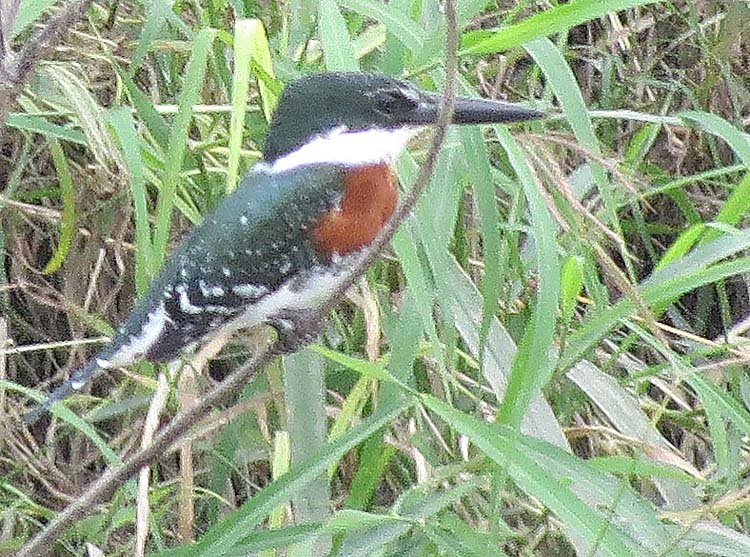
There were Green Kingfishers at a number of places we visited. This one at Mission was a male, and unlike Belted Kingfishers, the male has more color in this species.
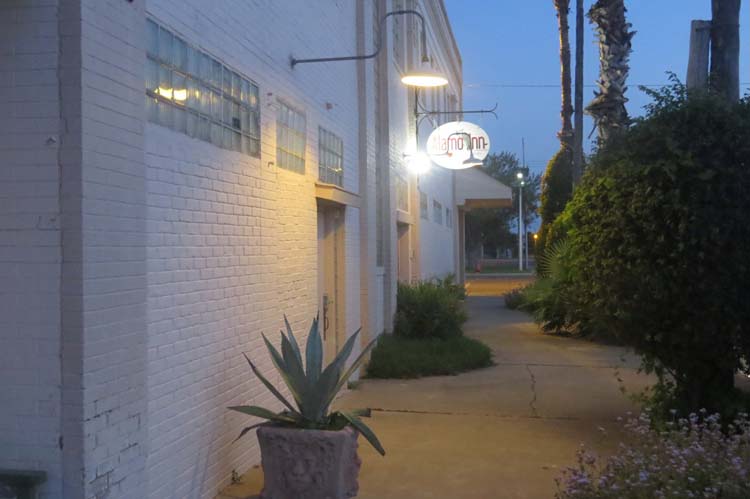
The whole time we stayed at the Alamo Inn in Alamo. This is an amazing place totally set up to meet the needs of anyone wanting to enjoy nature in the lower Rio Grande valley. I recommend it highly without reservations, actually, you might need reservations. They have everything set up so birding, butterflying or whatever is easy out of there plus a lot of touches that you’ll really appreciate like the chance to access breakfast food as early as you want, chic clothing with pictures of glamorous birds, and what’s really great is that nothing has gone to the owner’s head and prices are still reasonable.
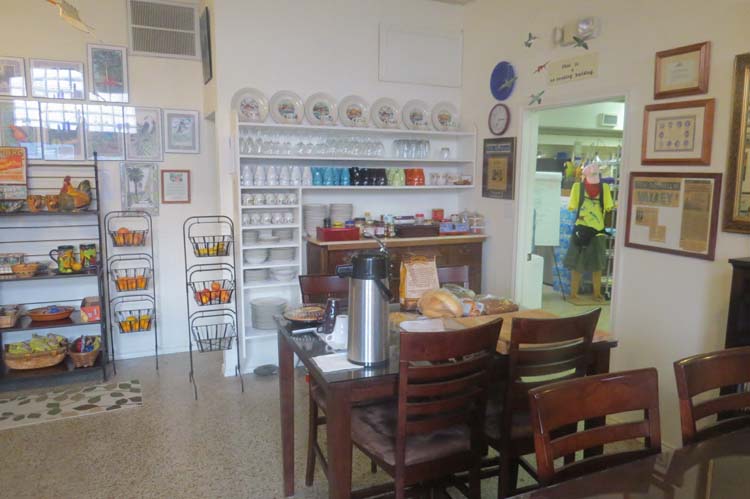
For an old guy like me this visit carried some sadness. In 1953 the Falcon Dam stopped the annual flooding of the Rio Grande valley and signed the death warrant for the tall Riparian forest in the lower valley.
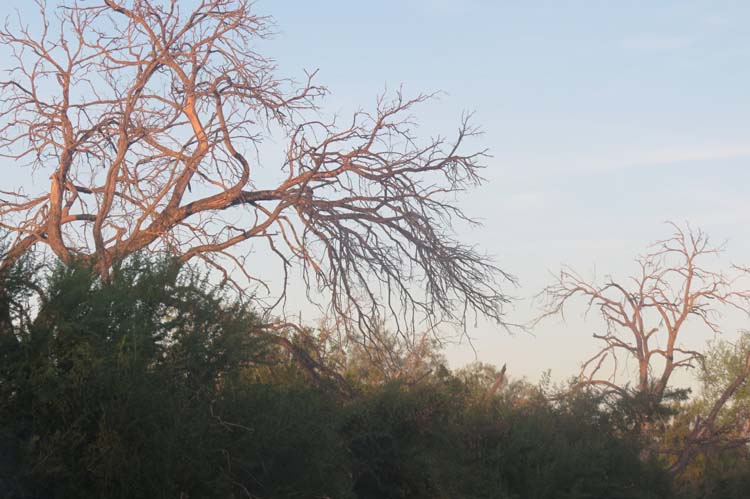
I visited in 1979 and although we were in a hurry, I remember a lush tropical forest along the river. People told us then: This forest is doomed because of the dam. Now almost all that’s left of the old forest is some pretty tall dead trees like these in Benson. The forest that has come into the valley to replace the old riparian forest is the Tamalipas Thorn-scrub Forest, native to the upland areas to the north and south of the Rio Grande. It’s characterized by large Mesquite trees and I think is a classic example of “chapparal” but I have to check on that.
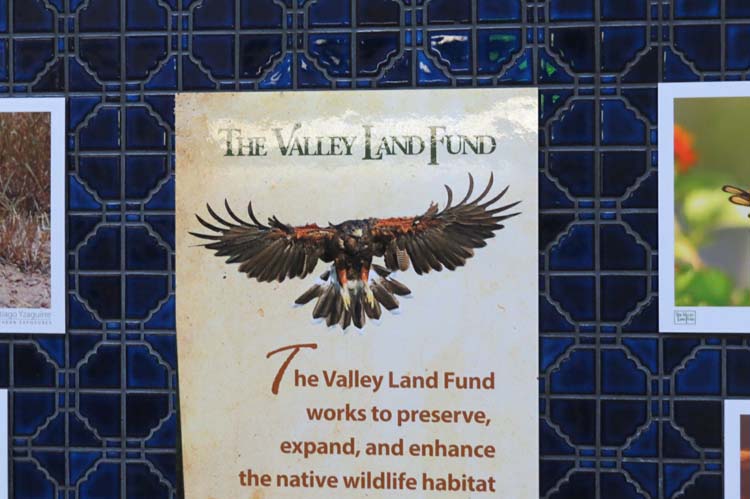
Another thing that’s troubling is the rural places being developed at such a fast rate. Every forest and field had a for sale sign on it. It’s great to see people prospering and doing well, but it’s a race against time to save enough land in the valley so that the spectacular birds and wildlife can survive. In the airport we found this sign of people doing this work: The Valley Land Fund. The Valley land fund is trying to save a bit of the old Rio Grande valley so when it’s gone, it’s not all gone. Here is a link:
http://valleylandfund.com/
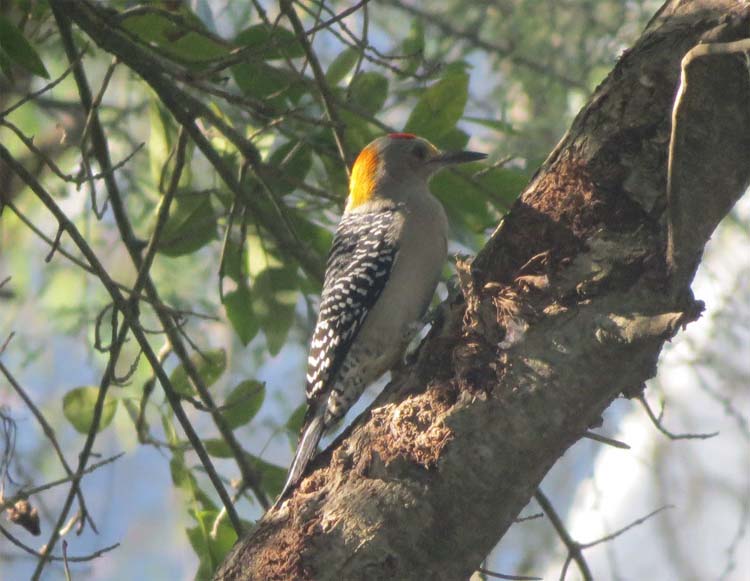
Regardless of politics, most people see these land-rushes that turn everything from greenfield to suburban development as a result of the market, and of course they are largely correct in that. But there’s a nuance rarely commented on in the political discussion in theis country. That is the effect of the property tax. Property tax distorts the market by taxing wealth but only taxing one form of wealth, property. You might have $229 million in stocks and bonds and hedge funds, and property tax won’t touch it. But you can be a relatively cash-poor person who owns just a five acre field and you get hammered every year for property tax. It’s the tax on wildlife habitat is what it is. When there’s a land rush like in the valley, the land-rich owners who are less wealthy face the carrot of the temptation of the sale price plus the stick of increased property taxes if they don’t sell and as a result there are no “curmudgeon parks” owned by people who have lived on the land all their lives, never gotten fabulously wealthy, but aren’t tempted by the money to cash out. Obviously I understand that government needs to raise money and we can’t just eliminate the property tax, but at the very least we should be aware of its many insidious consequences.
The Golden-fronted Woodpecker shown above, like the Tropical Kingbird, seems determined to survive regardless. Both birds were common in the urbanized areas and we ticked both birds most mornings as we stumbled out of the Alamo Inn at dawn.

List of Birds seen on the Great Mess with Texas Bird Tour of 2015
| House Sparrow |
|
| Golden-fronted Woodpecker |
| Great-tailed Grackle |
| Mourning Dove |
|
| Eurasian Collared Dove |
| Tropical Kingbird |
|
| Eurasian Starling |
|
| Rock Pigeon |
|
| American Kestrel |
|
| Red-winged Blackbird |
| Harris Hawk |
|
| Scissor-tailed Flycatcher |
| Turkey Vulture |
|
| Northern Mockingbird |
| Green Jay |
|
| Inca Dove |
|
| Orange-crowned Warbler |
| Great Kiskadee |
|
| Bronzed Cowbird |
|
| Northern Cardinal |
|
| Audubon’s Oriole |
|
| Black-crested Titmouse |
| Olive Sparrow |
|
| Plain Chachalaca |
|
| Ladder-backed Woodpecker |
| Long-billed Thrasher |
| Eastern Phoebe |
|
| White-tipped Dove |
|
| White-winged Dove |
| Altamira Oriole |
|
| Blue-gray Gnatcatcher |
| Osprey |
|
|
| Great Egret |
|
| Snowy Egret |
|
| Spotted Sandpiper |
|
| Neotropical Cormorant |
| American Pipit |
|
| Zone-tailed Hawk |
|
| Lesser Nighthawk |
|
| Black Phoebe |
|
| Crested Caracara |
|
| Cave Swallow |
|
| Cattle Egret |
|
| Great Blue Heron |
|
| White-tailed Hawk |
|
| Yellow-bellied Sapsucker |
| White-fronted Goose |
| Snow Goose |
|
| Ruby-throated Hummingbird |
| Curve-billed Thrasher |
| Buff-bellied Hummingbird |
| Barn Swallow |
|
| Cooper’s Hawk |
|
| Red-shouldered Hawk |
| Gray Hawk |
|
| Common Yellowthroat |
| Sharp-shinned Hawk |
| Ruby-crowned Kinglet |
| American Robin |
|
| Lincoln’s Sparrow |
|
| Belted Kingfisher |
|
| Monk Parakeet |
|
| Western Meadowlark |
| Tree Swallow |
|
| Rough-winged Swallow |
| Reddish Egret |
|
| Ring-necked Duck |
|
| House Finch |
|
| Black-throated Green Warbler |
| Black and White Warbler |
| Killdeer |
|
|
| Lesser Goldfinch |
|
| Black Vulture |
|
| Double-crested Cormorant |
| Green Kingfisher |
|
| Red-tailed Hawk |
|
| Greater Pewee |
|
| Broad-winged Hawk |
| Swainson’s Hawk |
|
| Vermillion Flycatcher |
| Verdin |
|
|
| Eastern Bluebird |
|
| House Wren |
|
| Anhinga |
|
|
| Yellow-rumped Warbler |
| White-eyed Vireo |
|
| Chipping Sparrow |
|
| Yellow-throated Warbler |
| Blue-headed Vireo |
|
| American Coot |
|
| Black-bellied Whistling Duck |
| White Pelican |
|
| White-tailed Kite |
|
| Common Gallinule |
|
| Loggerhead Shrike |
|
| Pied-billed Grebe |
|
| Blue-winged Teal |
|
| Gadwall |
|
|
| Black-crowned Night Heron |
| Yellow-crowned Night Heron |
| Common Parauque |
|
| Common Ground-Dove |
| American Avocet |
|
| Groove-billed Ani |
|
| Northern Shoveler |
|
| Roseate Spoonbill |
|
| Little Blue Heron |
|
| Tri-colored Heron |
|
| Sora |
|
|
| Savannah Sparrow |
|
| Field Sparrow |
|
| Mottled Duck |
|
| Northern Pintail |
|
| Ruddy Duck |
|
| Carolina Wren |
|
| Indigo Bunting |
|
| Least Grebe |
|
| Swamp Sparrow |
|
| Eastern Screech-Owl |
| Couch’s Kingbird |
|
| Least Sandpiper |
|
| Long-billed Dowitcher |
| Green Parakeet |
|
| Clay-colored Thrush |
|
| Greater Yellowlegs |
|
| Northern Bobwhite |
|
| Northern Beardless Tyrannulet |
| White-faced Ibis |
|
| Wilson’s Snipe |
|
| Lesser Yellowlegs |
|
| Green Heron |
|
| Ringed Kingfisher |
|
| Eastern Meadowlark |
| Pyrrhuloxia |
|
| Greater Roadrunner |
|
| Say’s Phoebe |
|
| White-crowned Sparrow |
| Bewick’s Wren |
|
| Northern Harrier |
|
| Cinnamon Teal |
|
| Fulvous Whistling Duck |
| White Ibis |
|
| Merlin |
|
|
| Northern Jacana |
|
| American Wigeon |
|
| Green-winged Teal |
|
| Western Sandpiper |
|
| Long-billed Curlew |
|
| Sandhill Crane |
|
| Wood Stork |
|
| Forster’s Tern |
|
| Aplomado Falcon |
|
| Horned Lark |
|
| Willet |
|
|
| Laughing Gull |
|
| Brown Pelican |
|
| Sanderling |
|
| Black Skimmer |
|
| Caspian Tern |
|
| Ruddy Turnstone |
|
| Elegant Tern |
|
| Gull-billed Tern |
|
| Dunlin |
|
|
| Semipalmated Plover |
| Semipalmated Sandpiper |
| Black-necked Stilt |
|
| Piping Plover |
|
| Black-bellied Plover |
| Sandwich Tern |
|
| Snowy Plover |
|
| Magnificent Frigatebird |
| Peregrine Falcon |
|
| Common Tern |
|
| Herring Gull |
|
| Redhead |
|
|
| Least Bittern |
|
| Gray Catbird |
|
| Franklin’s Gull |
|
| Red-crowned Parrot |
| White-fronted Parrot |
| Black-throated Gray Warbler |
| Hooded Oriole |
|
| Yellow Warbler |
|
| Pine Warbler |
|
| Great Horned Owl |
|
| Sprague’s Pipit |
|
| Wild Turkey |
|
| Northern Parula |
|
| Rose-breasted Grosbeak |
| Nashville Warbler |
|
| Tropical Parula |
|
| Bell’s Vireo heard only |
| Cassin’s Sparrow |
|
| Cactus Wren |
|
| American Goldfinch |
|
|
| Ring-billed Gull |
|
|
| That’s 196, I seem to be missing about 6 species, although some are ones Brian saw and I didn’t. I’ll try to get Brian’s ebird list here, that will have everything. |
|
|
|
|
|
|
|
|
|
|
|
|
|
|
|
|
|
|
|
|
|
|
|
|
|
|
|
|
|
|
|
|
|
|
|
|
|
|
|
|
|
|
|
|
|
|
|
|
|
|
|
|
|
|
|
|
|
|
|
|
|
|
|
|
|
|
|
|
|
|
|
|
|
|
|
|
|
|
|
|
|
|
|
|
|
|
|
|
|
|
|
|
|
|
|
|
|
|
|
|
|
|
|
|
|
|
|
|
|
|
|
|
|
|
|
|
|
|
|
|
|
|
|
|
|
|
|
|
|
|
|
|
|
|
|
|
|
|
|
|
|
|
|
|
|
|
|
|
|
|
|
|
|
|
|
|
|
|
|
|
|
|
|
|
|
|
|
|
|
|
|
|
|
|
|
|
|
|
|
|
|
|
|
|
|
|
|
|
|
|
|
|
|
|
|
|
|
|
|
|
|
|
|
|
|
|
|
|
|
|
|
|
|
|
|
|
|
|
|
|
|
|
|
|
|
|
|
|
|
|
|
|
|
|
|
|
|
|
|
|
|
|
|
|
|
|
|
|
|
|
|
|
|
|
|
|
|
|
|
|
|
|
|
|
|
|
|
|
|
|
|
|
|
|
|
|
|
|
|
|
|
|
|
|
|
|
|
|
|
|
|
|
|
|
|
|
|
|
|
|
|
|
|
|
|
|
|
|
|
|
|
|
|
|
|
|
|
|
|
|
|
|
|
|
|
|
|
|
|
|
|
|
|
|
|
|
|
|
|
|
|
Did you read this far? Thanks!!! See you in Texas sometime!














































Sorry, the comment form is closed at this time.